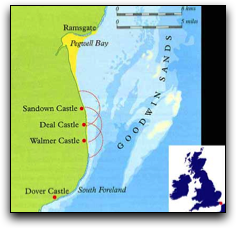

Goodwin Sands
Only a 7 mile trip from our Dover Sea Safari base.
The Goodwin Sands, graveyard of many fine ships and seamen, lie roughly between the North and South Forelands, some 3½ miles east of Deal. They are twelve miles in length and five miles wide at their widest part.
The tides ebbing and flowing through the narrow neck of the Dover Straits have built up these massive sandbanks whose outlines are constantly altering and whose existence has always been a hazard to vessels navigating these waters. At high water the sands are completely covered but as the tide falls they break the surface and expose perhaps a tenth of their total area, with some parts then being up to 13 feet above the sea.
The golden line of sand seen from the shore on a fine summer day gives little idea of the awesome aspect of the Sands on a winter's night as the gale driven surf roars and lashes wildly over them, or of the eerie sounds of the unseen bellbuoy and the wash of shoal water heard through the murk of dense fog.
Lying along one of the world's busiest seaways, the Sands have always presented a menace to shipping and even today, despite the wonders of scientific aids to navigation, they lie in wait to extract a heavy penalty from any vessel which grounds upon them. Deep water lies close along their eastern edge and any vessel striking here is in immediate danger of breaking her back as the tide falls (as much as eighteen feet at Springs) and leaves her bows fast in the Sand and her stern unsupported. A vessel running fully on to the Sands is in no better position; for the tides will sweep the sand from under her bow and stern to leave her supported only amidships and liable to break her back.
As time passes the wrecks slowly corrode and either 'swaddle down' into the Sands or slide off the edge into deeper water as the tides alter the shape of the edges and the waves pound at the hulks.
The Goodwins have been responsible for countless wrecks; one of the worst in recent years being that of the South Goodwin Light Vessel in November 1954, when she parted her riding cable in a gale and was driven on to the Sands to become a total loss. Only one man was saved, miraculously sighted and lifted from the wreck by a helicopter after clinging to the rigging for eight hours.
The Goodwins have been responsible for countless wrecks; one of the worst in recent years being that of the South Goodwin Light Vessel in November 1954, when she parted her riding cable in a gale and was driven on to the Sands to become a total loss. Only one man was saved, miraculously sighted and lifted from the wreck by a helicopter after clinging to the rigging for eight hours.
Two wrecks are visible at low tide. The 'North Eastern Victory', whose clutter of masts and kingposts may easily be seen on a clear day, whilst a little further to the South, the top of one of the kingposts of the 'Luray Victory' can still be picked out. These American cargo vessels were wrecked during 1946 and from each the Walmer Lifeboat saved the entire crew.
Help to those in peril has always been rendered by the boatmen of this coast, and in the days of the sailing and pulling Lifeboats those stationed at Ramsgate, North Deal, Walmer and Kingsdown were famed for their services on the Sands. With the advent of the motor lifeboat the stations at North Deal and Kingsdown were united at Walmer, whose present lifeboat and volunteer crew are worthy descendants of the old 'Seamen of The Downs'.
Often it is possible to see over the Walmer Lifeboat Station itself and scan the Service Boards recording some of the rescues rendered in 120 years which saved 2,100 lives besides salvaging valuable shipping.
Arranged visits to this Lifeboat Station are encouraged and numerous school parties from a variety of areas in the south make the visit every year from April to July.
Constant watch, both visual and by radio, and radar over the Goodwins is kept by Dover Coastguard (Dover Straits), which is responsible for initiating and co-ordinating marine rescue of all kinds from the North Foreland Lighthouse to Beachy Head and far out to sea.
Help to those in peril has always been rendered by the boatmen of this coast, and in the days of the sailing and pulling Lifeboats those stationed at Ramsgate, North Deal, Walmer and Kingsdown were famed for their services on the Sands. With the advent of the motor lifeboat the stations at North Deal and Kingsdown were united at Walmer, whose present lifeboat and volunteer crew are worthy descendants of the old 'Seamen of The Downs'.
Often it is possible to see over the Walmer Lifeboat Station itself and scan the Service Boards recording some of the rescues rendered in 120 years which saved 2,100 lives besides salvaging valuable shipping.
Arranged visits to this Lifeboat Station are encouraged and numerous school parties from a variety of areas in the south make the visit every year from April to July.
Constant watch, both visual and by radio, and radar over the Goodwins is kept by Dover Coastguard (Dover Straits), which is responsible for initiating and co-ordinating marine rescue of all kinds from the North Foreland Lighthouse to Beachy Head and far out to sea.
Cricket
In the summer of 1824, Captain K. Martin, then the Harbourmaster at Ramsgate, instituted the proceedings of the first known cricket match on the Goodwin Sands, at low water. Such was the tenacity of local mariners, a tradition sprung up that survives to this day, whereby those so inclined make the journey to the Sands for a leisurely few hours in pursuit of this very English past-time.
When hovercraft ran from Dover, they used to make occasional trips to the sands. An annual cricket match was until 2003 played on the sands at low tide, and a crew filming a reconstruction of this for the BBC television series Coast had to be rescued by the RNLI lifeboats when they experienced difficulty in 2006.
In the summer of 1824, Captain K. Martin, then the Harbourmaster at Ramsgate, instituted the proceedings of the first known cricket match on the Goodwin Sands, at low water. Such was the tenacity of local mariners, a tradition sprung up that survives to this day, whereby those so inclined make the journey to the Sands for a leisurely few hours in pursuit of this very English past-time.
When hovercraft ran from Dover, they used to make occasional trips to the sands. An annual cricket match was until 2003 played on the sands at low tide, and a crew filming a reconstruction of this for the BBC television series Coast had to be rescued by the RNLI lifeboats when they experienced difficulty in 2006.
Potential airport site
In 1974 a plan was put forward to build a third London airport on the Goodwin Sands, with a huge harbour complex.
To this day the idea still occasionally goes under consideration.
Being far from residential areas it has the advantage of 24 hour-a-day take-offs and landings without causing disturbance.
Very similar to Kansai International Airport as pictured
In 1974 a plan was put forward to build a third London airport on the Goodwin Sands, with a huge harbour complex.
To this day the idea still occasionally goes under consideration.
Being far from residential areas it has the advantage of 24 hour-a-day take-offs and landings without causing disturbance.
Very similar to Kansai International Airport as pictured
